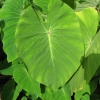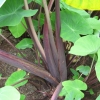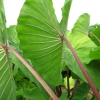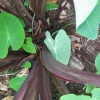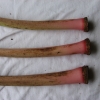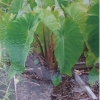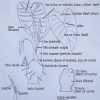Use As Food
Mainly as table taro for home use. The taro has excellent quality as a table taro. The Mana and the Lauloa taros are used in preference to all others for making the Hawaiian pudding kūlolo, a combination of grated taro and coconut milk.
Distribution
Comparatively rare; planted in a few scattered localities on Hawai‘i and Maui, nearly always under upland, dryland culture (māla).
General Characteristics
Medium in height to tall, slender, erect, maturing within 9 to 12 months, producing two or three branches; readily identfied by purplish-red flecking along the entire hā (Petiole), with almost complete absence of green coloration.
Ha (Petiole)
70 to 90 cm. tall, slender, slightly curved at apex, flecked with purplish-red, almost lacking in green, with narrow reddish edge, a dark reddish-purple ring at kōhina (base) with lilac-pink for about 3 cm, above.
Lau or Lu'au(Leaf Blade)
40 to 50 cm. long, 30 to 35 cm. wide, 35 to 45 cm. from tip to base of sinus (māwae), egg-shaped (ovate), thin in texture, light green; margins slightly wave-like (undulate); piko small, purple; veins purplish on lower surface of round leaf section (lobes); round leaf section (lobes) acute with narrow lihi māwae (sinus).
'I'o kalo (Corm)
Flesh white tinged with pink, especially near apex, with yellowish fibers; skin dark lilac-pink.
Pua (Flower)
Hā (peduncle) light purplish flecked with dark reddish-purple areas at kōhina (base) and above constriction (skinny part of flower); flower cover (spathe) 14 to 17 cm, long, the lower tubular portion about 3 cm, long, light purplish flecked with dark reddish-purple at kōhina (base) and at constriction (skinny part of flower), the upper portion yellow, tightly rolled spadix (spike of flower) 4 to 5 cm, long, slender, the sterile appendage (tip of flower's spike) 5 to 6 mm. long.
Remarks

